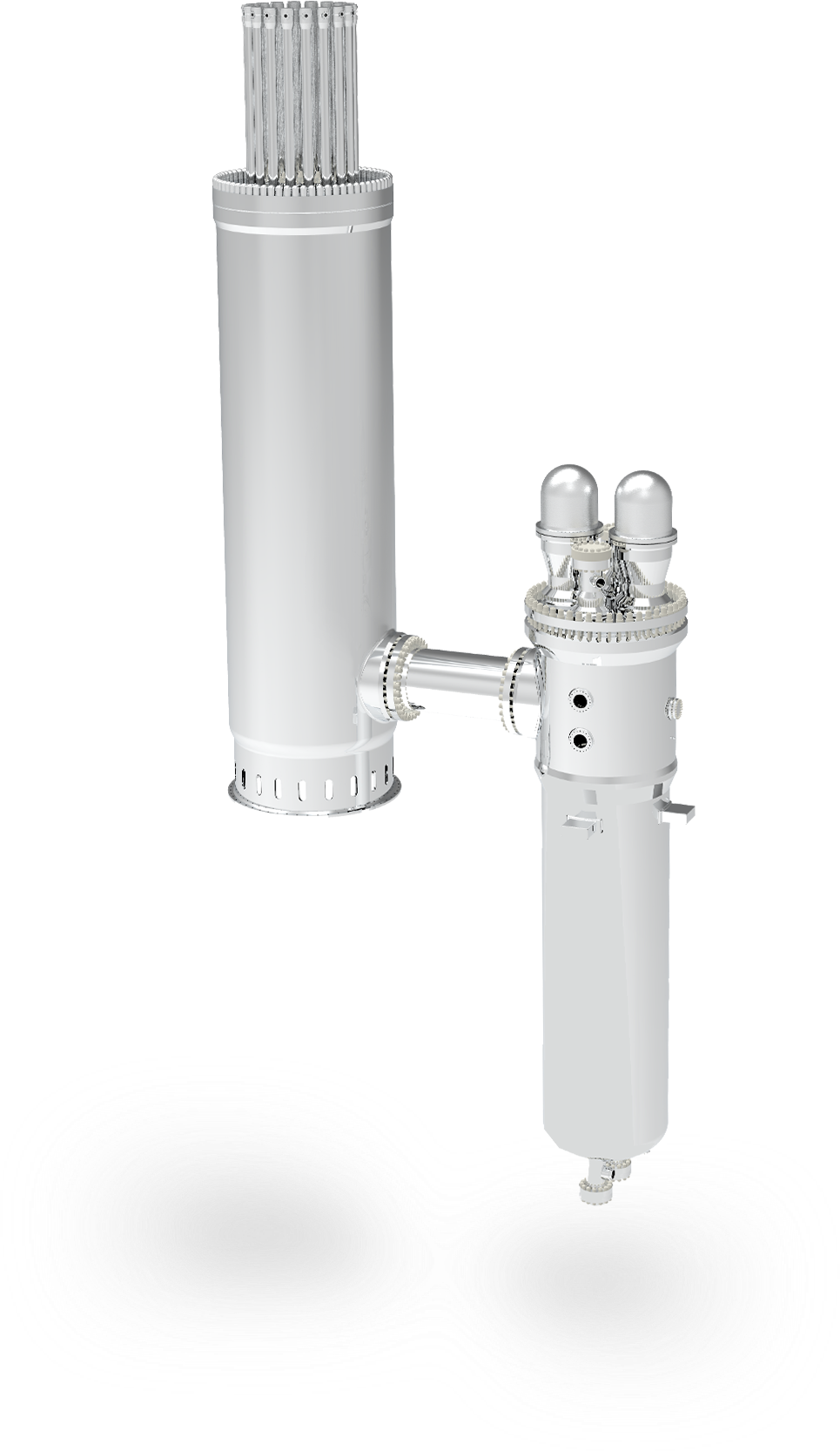
Control rods are made of Inconel with boron sandwiched between an inner and outer Inconel cylinder
Helium Pressure: 6.0 MPa
Designed for a 60 year operating life
Feed-water inlet temperature: 220°C
All material used falls within existing ASME code cases
Small Modular Nuclear Reactor: Xe-100
We’re focused on Gen-IV High-Temperature Gas-cooled Reactors (HTGR) as the technology of choice, with advantages in sustainability, economics, reliability and safety.
Our design hits a sweet spot in balancing size, cost & build time.
Here’s How:
Sized for the Future
Xe-100 is a 80 MWe reactor that can be scaled into a ‘four-pack’ 320 MWe power plant—with our modular design, the scale can grow even larger as needed.
Our base model is 80 MWe
Geographic Flexibility
As a leading entry in a class of small modular reactors (SMRs) our design brings nuclear power within reach for countries, utilities & communities.
Deployment @ Point of Need
Affordability
Our elegant and simple design maximizes the use of off-the-shelf components manufactured and shipped to site using existing road & rail.
Smart Design = Simplified Effort
Our Reactor
X-energy’s nuclear reactor designs are based on HTGR technology — a Generation-IV reactor technology with a proven operational pedigree.
Xe-100
220,000 Graphite Pebbles with TRISO Particle fuel
High temperature tolerant graphite core structure
ASME compliant reactor vessel, core barrel & steam generator
Designed for a 60-year operational life
Flexible application – electricity and/or process heat
Base load or load following
Online refueling (95% plant availability)
High burn-up fuel cycle (160 GWd/tHM)
200 MW …Thermal Output
80 MW …Electric Output
750°C …Helium Temperature
6 MPa …Helium Pressure
565°C …Steam Temperature
16.5 MPa …Steam Pressure
A simple design & modularized components
Road deliverable modules allow us to reinvent the Nuclear plant delivery model. Module size & weight allows transportability using existing road & rail infrastructure, leading to scalability, timeline & cost control never before seen in nuclear energy.
Our Reactors = 400 meters Safety Perimeter (vs 10 miles!)
With a simple design, meltdown-proof ‘walk-away’ safety, and the most robust encapsulated fuel, our approach is the safest and most secure of the Gen-IV approaches.

Our design team brings decades of experience
Our design team brings decades of experience from the HTGR pebble-bed design programs in Germany and South Africa, combined with veterans of the Advanced Gas Reactor program in the US and leading experts from the U.S. Department of Energy National Laboratories.
“We’re proud our reactors are getting recognition for being the safest.”
Dr. Martin van Staden
Vice President, Reactor Development
-
The Xe-100 reactor is a small modular nuclear reactor developed by X-energy. It is based on High-Temperature Gas-cooled Reactor (HTGR) technology. X-energy's nuclear technology represents the next generation of clean, safe, reliable, and zero-carbon nuclear energy.
-
The Xe-100 advanced small modular reactor is designed to produce 80 MW of electricity, or 200 MW thermal. However, it can be scaled up into a 'four-pack' configuration, allowing for a total power output of 320 MW.
-
Our reactors use TRISO particle fuel, a technology that has been developed and improved over 60 years. The DOE describes TRISO particles as “the most robust nuclear fuel on the planet.” We manufacture our own proprietary TRISO fuel, TRISO-X, through our wholly owned subsidiary, TRISO-X, LLC, to ensure supply and quality control.
-
The Xe-100 is designed to be intrinsically safe. With only four operator-controlled variables (control rods, helium circulator, feedwater pump and turbine throttle valve), opportunities for operator error are drastically reduced, and automated operations allow for fewer personnel on site. Additionally, TRISO-X fuel is designed not to melt and can withstand extreme temperatures.
-
The Xe-100 reactor is designed for a 60-year operational life, ensuring long-term sustainability and reliability.
-
Yes, the Xe-100 reactor is flexible in its application and can provide both electricity and process heat, making it suitable for various industrial processes.
-
Yes, the Xe-100 has load-following capabilities, and is designed to ramp up or ramp down between 40% and full power in 12 minutes, faster than what is achievable by existing Generation III nuclear technologies.
The Xe-100 has a versatile design that can be applied to several end markets, as well as to conventional power generation.
-
The Xe-100 reactor's modular design allows for road delivery of components, enabling transportation using existing road and rail infrastructure. This approach enhances scalability, control over timelines, and cost-effectiveness.
-
Our design and engineering team brings decades of experience from the HTGR pebble-bed design programs in Germany and South Africa, combined with veterans of the Next Generation Nuclear Plant program in the United States and leading experts from the DOE National Laboratories.
-
The Xe-100 reactor offers several advantages, including its safety features, economic viability, and advanced design. It maximizes the use of off-the-shelf components, simplifying efforts and reducing costs. The scalability and flexibility of the Xe-100 reactor make it accessible to countries, utilities, and communities, bringing nuclear power within reach.
We’re Hiring
Developing state-of-the-art, high technology solutions for reactors and fuel requires both traditional nuclear and non-traditional engineering skills and experience. We’re looking for capabilities in solution development, multi-disciplinary analysis, systems engineering, facility design, test planning, logistics, management, and system integration.













